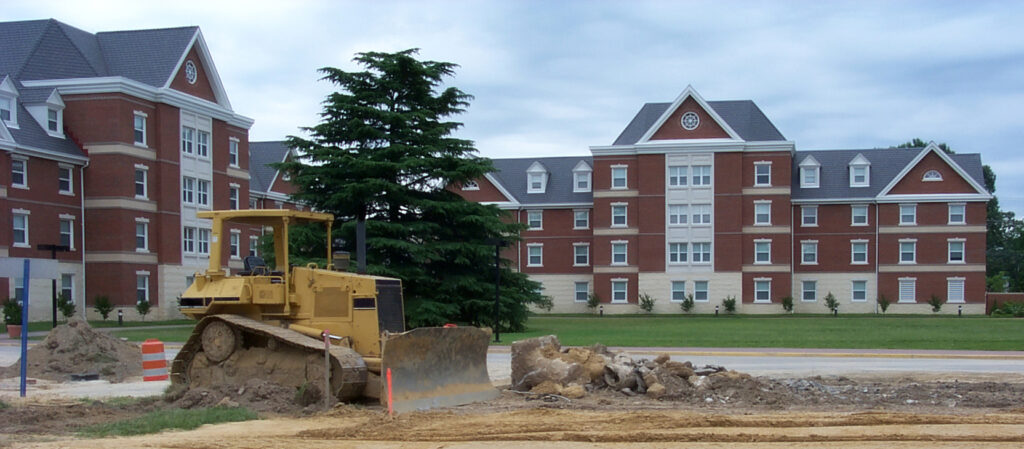Construction Air Quality Monitoring for Higher Education

Putting a real-time air quality monitoring plan in place prior to a complicated demolition or interior renovation project can give universities an additional layer of assurance that they’re protecting sensitive populations in the area. Too often plans to control dust emission on demolition or renovation projects get overlooked. Once demolition has begun—and complaints of dust in adjacent buildings or strange odors start coming in—universities are likely to find that the cleanup and communication process is much more difficult and costly than putting a proactive plan in place would have been.
Real-time environmental monitoring can prove to be an effective proactive method of protection for any project where there’s a potential to impact the surrounding areas, from large-scale demolitions to small-scale interior renovations. This added layer of controls can give all project stakeholders the assurance they need that no hazardous materials are escaping at levels that could impact students, staff or local residents.
Creating an Environmental Monitoring Plan
It’s standard for construction projects to have protocols in place for containing hazardous materials ranging from lead paint to PCBs to asbestos and the like. However, putting an automated real-time air quality monitoring system in place provides a safeguard in the event that the first level of containment fails.
An effective air quality monitoring plan typically begins with a building specific risk assessment. For universities, this might also include identifying unique items, such as certain chemicals that may have been housed in a research laboratory that may demand special handling. The assessor will ascertain levels of the identified contaminants and identify health and safety concerns around these materials.
Next, it’s important to look at the surrounding areas to understand what “receptors” could potentially be impacted by any renovation or demolition work. If this is a small-scale renovation, will the floors above and below be impacted by the work? For larger demolitions, how densely packed is the surrounding area? Beyond local homes, are there nearby hospitals or schools adding to the at-risk population?
With these two pieces of information in place, the university can begin to put together a plan to keep projects moving smoothly and safely. Numerous options are available for air quality monitors. Many sensors provide around the clock data collection, but some logging devices may require that the information be gathered and then downloaded later. Alternately, live environmental monitors work in real-time to collect data and alert project parties instantly if elevated levels of target substances are detected. So, if an operation is creating a lot of dust beyond the containment barrier that is above the set baseline, the system can warn stakeholders to investigate in time to take action before the community is impacted.
The monitoring process also puts a preset plan in place for how to react to different occurrences, based on the level of intensity. With real-time air quality monitoring, it becomes very simple to identify issues before they escalate and adjust processes to prevent a larger problem from occurring.
A Case of High Risk Hazards
When the University of Cincinnati prepared to demolish an academic research laboratory facility, they knew many hazards would be associated with the building. The facility had housed pioneers in occupational and environmental medicine and, given its storied history, the campus community knew it had to handle the project as safely as possible to address these risks.
Environmental Health & Engineering (EH&E) was brought in to provide an added level of protection around this project. The monitoring process began with the hazardous material assessment. Through a review of historic use records and past renovations, as well as onsite field sampling for contaminants, the team found evidence of a wide range of hazards from beryllium and mercury to radioactive materials. Next, the team looked at potential receptors and found a number of sensitive areas that needed protection. There was a hospital and an environmental health college closely located to the laboratory, and a preschool in the area and a residential community right across the street.
Based on the information gathered, much of the project demolition was done in tightly controlled units inside the building. The team put controls in place to minimize the dust generated. They also monitored around the entire building perimeter so if any contaminant got out they were able to notify the university immediately, so they could stop the breach.
Communicating with Project Stakeholders
One reason for the success behind the complex University of Cincinnati project was the early involvement of the EH&E team and the upfront communication with a broad range of project stakeholders.
Stakeholder groups might vary across projects. Larger projects might involve members of the community, as well as campus representatives from the environmental health and safety department, campus planning and residence life representatives, as well as faculty. It’s important to gain input from everyone who may be impacted by this work with hazardous materials, to ensure that all concerns are addressed and they’re comfortable with the process.
This input, and attention to detail, matters for projects of every size. While it’s obvious that a large demolition of a laboratory is likely to need an extra layer of controls, it’s not unusual for the smallest renovation projects to cause the biggest problems. On small-scale renovations it may be tempting to try to do the work quickly, without layers of controls in place. But any time walls, floors or systems are opened up in the middle of a campus building, people may be impacted. It’s important that any renovation project be closely examined for its potential hazards so that these institutions can take care of the people who live and work on, or near, their campus.
If you have an upcoming construction project and are concerned about controlling hazards on your campus, contact us today to learn how we can help.
Subscribe
to our blog
"*" indicates required fields




